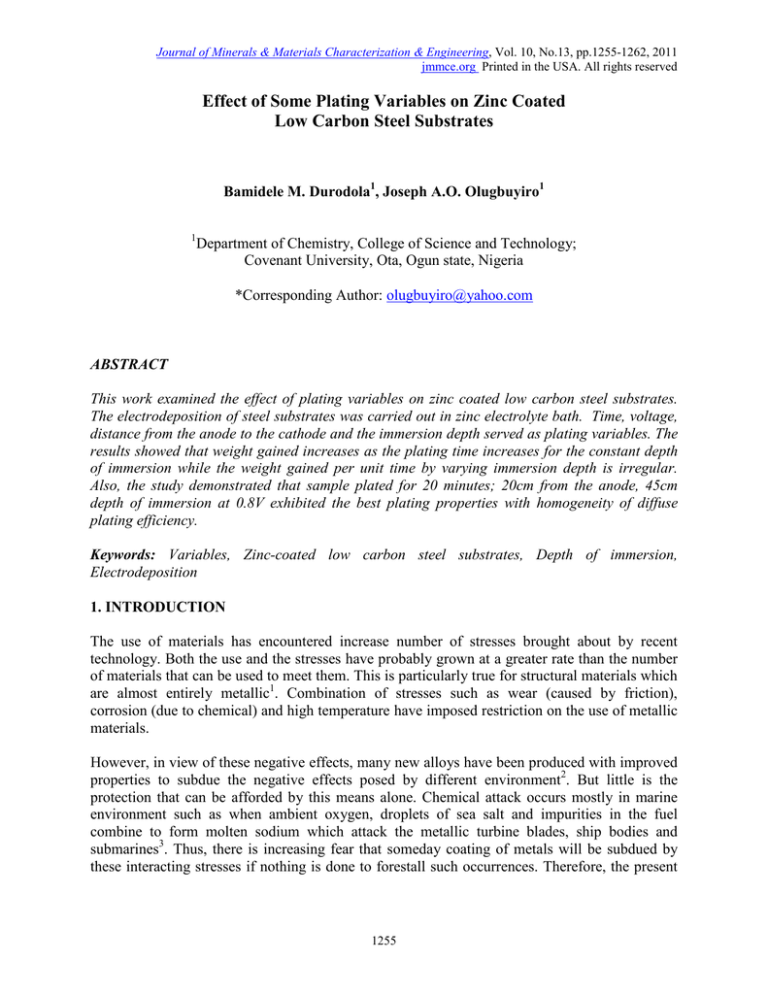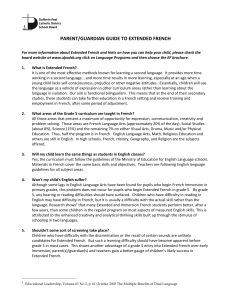
Journal of Minerals & Materials Characterization & Engineering, Vol. 10, No.13, pp.1255-1262, 2011
jmmce.org Printed in the USA. All rights reserved
Effect of Some Plating Variables on Zinc Coated
Low Carbon Steel Substrates
Bamidele M. Durodola1, Joseph A.O. Olugbuyiro1
1
Department of Chemistry, College of Science and Technology;
Covenant University, Ota, Ogun state, Nigeria
*Corresponding Author: olugbuyiro@yahoo.com
ABSTRACT
This work examined the effect of plating variables on zinc coated low carbon steel substrates.
The electrodeposition of steel substrates was carried out in zinc electrolyte bath. Time, voltage,
distance from the anode to the cathode and the immersion depth served as plating variables. The
results showed that weight gained increases as the plating time increases for the constant depth
of immersion while the weight gained per unit time by varying immersion depth is irregular.
Also, the study demonstrated that sample plated for 20 minutes; 20cm from the anode, 45cm
depth of immersion at 0.8V exhibited the best plating properties with homogeneity of diffuse
plating efficiency.
Keywords: Variables, Zinc-coated low carbon steel substrates, Depth of immersion,
Electrodeposition
1. INTRODUCTION
The use of materials has encountered increase number of stresses brought about by recent
technology. Both the use and the stresses have probably grown at a greater rate than the number
of materials that can be used to meet them. This is particularly true for structural materials which
are almost entirely metallic1. Combination of stresses such as wear (caused by friction),
corrosion (due to chemical) and high temperature have imposed restriction on the use of metallic
materials.
However, in view of these negative effects, many new alloys have been produced with improved
properties to subdue the negative effects posed by different environment2. But little is the
protection that can be afforded by this means alone. Chemical attack occurs mostly in marine
environment such as when ambient oxygen, droplets of sea salt and impurities in the fuel
combine to form molten sodium which attack the metallic turbine blades, ship bodies and
submarines3. Thus, there is increasing fear that someday coating of metals will be subdued by
these interacting stresses if nothing is done to forestall such occurrences. Therefore, the present
1255
1256
Bamidele M. Durodola , Joseph A.O. Olugbuyiro
Vol.10, No.13
work has examined the effect of plating variables on zinc-coating low carbon steels, in particular,
to understudy more effective conditions for electrodeposition.
2 MATERIALS AND METHODS
2.1 Materials
The low carbon steel rod substrate used for this research was obtained from Osogbo Steel
Rolling in Osun State, Nigeria. The chemical composition of the steel was analysed with mass
spectrometer and analysis is shown in Table 1. The steel was later cut into cylindrical pieces with
dimension of 20mm diameter by 40mm length.
Table 1. Chemical Composition of Low Carbon Steel
Elements
C
S
Si
P
Mn
Ni
Cu
Mo
V
Ti
Al
Mg
Sn
Fe
wt%
0.18
0.08
0.10
0.62
0.75
0.010
0.23
0.082
0.005
0.002
0.006
0.004
0.008
97.60
2.2 Samples Pre-Treatment before Electroplating Operations
The samples were removed from the desiccators in turn and pickled in 0.5M H 2 SO 4 for 2
minutes, then rinsed in distilled water before degreasing in an 100 litre electrolytic degreasing
tank containing alkaline solution and rinsed in distilled water for 2 minutes. The samples were
weighed using a digital weighing balance model Mettler Toledo Pb153 of accuracy ± 0.001g and
the weight was recorded as the initial weight.
2.3 Electroplating Operation
The samples were electroplated at 0.8 volt for different plating times ranging from 10mins 30mins, and the distance from anode to cathode varied from 10cm-30cm at varying immersion
depth from 35cm-55cm. The surfaces of the samples were activated with acid solution. The
samples were then dipped into the zinc plating bath and the electroplating rectifier switched on.
The electroplated samples were removed, passivated, dried and the weights recorded.
3. RESULTS
Table 2: Weight Deposited (g) of Zinc on low carbon steel at
varying depth of immersion and at 10cm distance from anode
Weight
Weight deposited per
Gained(g)
unit area (mg/mm 2)
0.02
1.82
0.10
9.12
0.04
3.65
0.08
7.29
0.06
5.47
Voltage = 0.8V
Thickness
(µm)
0.052
0.260
0.104
0.208
0.156
Time
(Mins)
10
15
20
25
30
Immersion
Depth(cm)
35
40
45
50
55
Vol.10, No.13
Effect of Some Plating Variables on Zinc
1257
Table 3: Weight Deposited (g) of Zinc on low carbon steel at
constant depth of immersion and at 10cm distance from anode
Weight Gained
(g)
0.06
0.09
0.14
0.18
0.20
Voltage = 0.8V
Weight deposited
per
unit
area
(mg/mm 2)
5.47
8.20
12.76
16.41
18.23
Thickness
(µm)
Time
(Mins)
0.156
0.234
0.364
0.468
0.520
10
15
20
25
30
Immersion
Depth
(cm)
35
35
35
35
35
Table 4: Weight Deposited (g) of Zinc on low carbon steel
at varying depth of immersion and at 20cm distance from anode
Weight Gained
(g)
0.06
0.08
0.12
0.21
0.12
Voltage = 0.8V
Weight
deposited
per
unit
area
(mg/mm 2)
5.47
7.29
10.94
19.14
10.94
Thickness
(µm)
Time
(Mins)
0.156
0.208
0.312
0.534
0.312
10
15
20
25
30
Immersion
Depth
(cm)
35
40
45
50
55
Table 5: Weight Deposited (g) of Zinc on low carbon steel at constant
depth of immersion and at 20cm distance from anode
Weight Gained
(g)
0.04
0.07
0.12
0.15
0.18
Voltage = 0.8V
Weight
deposited Thickness
per
unit
area (µm)
2
(mg/mm )
3.65
0.10
6.38
0.18
10.94
0.31
13.67
0.39
16.41
0.47
Time
(Mins)
10
15
20
25
30
Immersion
Depth
(cm)
45
45
45
45
45
1258
Bamidele M. Durodola , Joseph A.O. Olugbuyiro
Vol.10, No.13
Table 6: Weight Deposited (g) of Zinc on low carbon steel at
varying depth of immersion and at 30cm distance from anode
Weight Gained
(g)
Weight deposited per Thickness
unit area (mg/mm 2)
( µm)
Time
(Mins)
0.18
0.04
0.08
0.10
0.18
Voltage = 0.8V
16.41
3.65
7.29
9.12
14.59
10
15
20
25
30
0.47
0.10
0.208
0.260
0.416
Immersion
Depth
(cm)
35
40
45
50
55
Table 7: Weight Deposited (g) of Zinc on low carbon steel at
constant depth of immersion and at 30cm distance from anode
Weight Gained
(g)
Time
(Mins)
10
15
20
25
30
Immersion
Depth
(cm)
55
55
55
55
55
Weight gained
(g)
0.02
0.05
0.08
0.10
0.18
Voltage = 0.8V
Weight
deposited Thickness
per
unit
area (µm)
(mg/mm 2)
1.82
0.052
4.56
0.130
7.29
0.208
9.12
0.260
14.59
0.416
Time (Mins)
Fig. 1 Plot of Weight gained (g) against Time (Mins) of zinc plated on low carbon steel at 10cm
from the anode and at varying and constant immersion depth
Effect of Some Plating Variables on Zinc
1259
Weight gained
(g)
Vol.10, No.13
Time (Mins)
Weight gained
(g)
Fig. 2 Plot of Weight gained (g) against Time (Mins) of zinc plated on low carbon steel at 20cm
from the anode and at varying and constant immersion depth
Time (Mins)
Fig. 3 Plot of Weight gained (g) against Time (Mins) of zinc plated on low carbon steel at 30cm
from the anode and at varying and constant immersion depth
Bamidele M. Durodola , Joseph A.O. Olugbuyiro
Vol.10, No.13
Coating thickness
(µm)
1260
Time (Mins)
Coating thickness
(µm)
Fig. 4 Plot of Thickness (µm) against Time (Mins) of zinc plated on low carbon steel at 10cm
from the anode and at varying and constant immersion depth
Time (Mins)
Fig. 5 Plot of Thickness (µm) against Time (Mins) of zinc plated on low carbon steel at 20cm
from the anode and at varying and constant immersion depth
Effect of Some Plating Variables on Zinc
1261
Coating thickness
(µm)
Vol.10, No.13
Weight gained
(g)
Time (Mins)
Fig. 6 Plot of Thickness (µm) against Time (Mins) of zinc plated on low carbon steel at 30cm
from the anode and at varying and constant immersion depth
Time (Mins)
Fig 7 Plot of Weight gained (g) against Time (Mins) of zinc plated on low carbon steel at
various constant distances 10cm, 20cm and 30cm from the anode
1262
Bamidele M. Durodola , Joseph A.O. Olugbuyiro
Vol.10, No.13
4. DISCUSSION
4.1 Effect of Immersion Depth on Weight Gained and Coating Thickness
Figures 1, 2 and 3 show that at given distances of 10cm, 20cm and 30cm from anode weight
gained increases as the plating time increases for the constant depth of immersion . However the
weight gained per unit time by varying immersion depth is irregular. There is no linear
relationship between electrodeposition and varying immersion depth. The same phenomenon is
reflected for the thickness of coat film as revealed in Figures 4-6. So, the immersion depth must
be controlled to avoid operating at point zero pumping action4.
However, Figure 5 projects a coincidence at 20mins plating time when the immersion depth was
kept constant at 45cm and when it was varied between 35cm and 55cm. This phenomenon could
probably explain the good electroplating effects experienced by the coated steel under the stated
conditions.
4.2 Effect of Distance from the Anode on Weight Gained
Figure 7 relates the weight deposited against time at different distances from the anode. This
indicates that as the distance from the anode increases the weight gained decreases.
5. CONCLUSION
This present study has demonstrated that electrodeposition increases at constant immersion depth
at a given particular distance from anode while there is no linear relationship between
electrodeposition and varying immersion depth.
However, this study showed that sample plated for 20 minutes; 20cm from the anode, 45cm
depth of immersion at 0.8V exhibited the best plating properties with homogeneity of diffuse
plating efficiency.
REFERENCES
[1] Allen, S.H; Holowenko, A.R and Laughlin, H.G; 1982. Theory and Problems of Machine
Design, McGraw Hill book company Inc. New York.
[2] Smith, W.F; 1990 Principle of materials science and Engineering, McGraw Hill international,
New York.
[3] Sedlacek, V; 1993. Metallic Surface, Films and Coatings, McGraw Hill, London.
[4] Durney, L. J; 1984 Electroplating Engineering Handbook 4th edition part 1, page 581.



